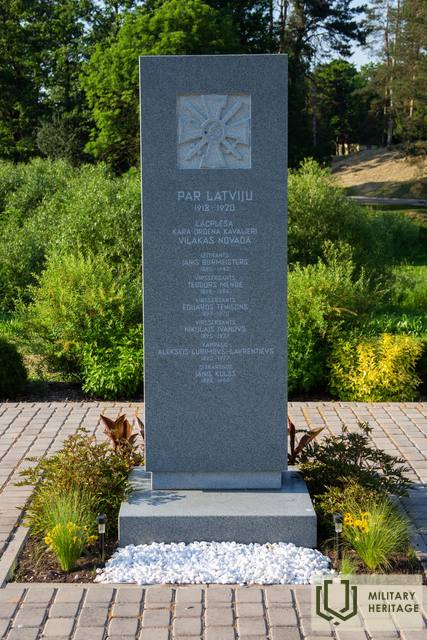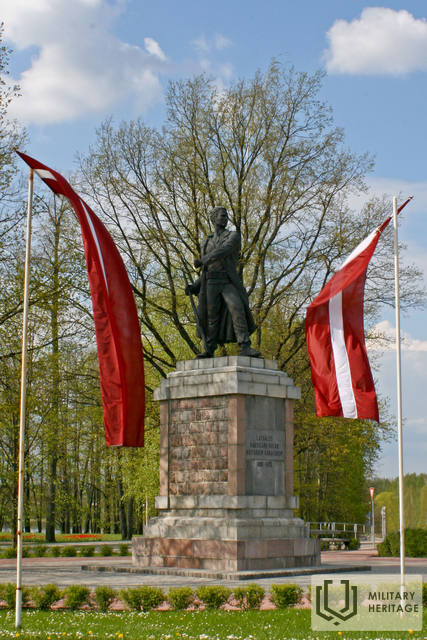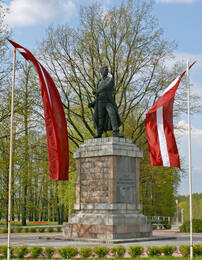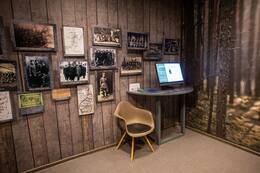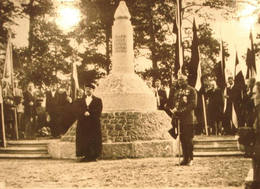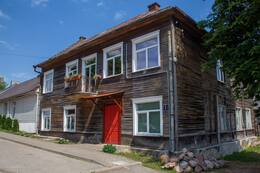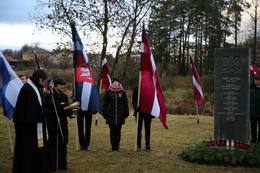Šiaurės Latgalos išvadavimas iš bolševikų
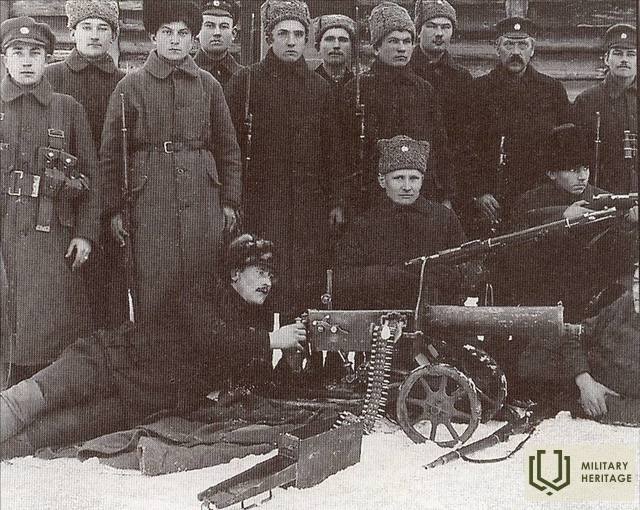
1918 m. gruodžio 1 d. Raudonosios armijos daliniai, paremti Raudonųjų šaulių daliniais, įsiveržė į Latvijos teritoriją. Siekdami apsaugoti savo namus, šeimas, gimtuosius rajonus, pabėgti nuo siaubo, Balvi apylinkių vyrai griebėsi ginklo ir ėjo į miškus, pradėjo kurtis pirmosios „žaliosios“ grupės. 1919 m. pavasarį, kai buvo paskelbta mobilizacija, daugybei Balvų apylinkių vyrų kovoti sovietinėje Latvijos armijoje atrodė nepriimtini ir jie prisijungė prie „žaliųjų“ grupuočių. Susikūrė Balvų, Silakrogo, Rugėjų, Teterių-Dūrupės ir Liepnos grupės. „Žaliųjų“ grupių veikla Balvių apylinkėse suaktyvėjo 1919 metų kovo mėnesį.
1919 m. gegužę, Latvijos laikinosios vyriausybės ginkluotosioms pajėgoms tęsiant puolimą rytų kryptimi, Balvų apylinkėse suaktyvėjo partizanų veikla. 1919 metų pavasarį susikūrė kelios partizanų grupės, kiekviena grupė turėjo savo vadą, o tarp atskirų „žaliųjų“ grupių bendravimo beveik nebuvo.
1919 m. gegužės – birželio mėn. Liepnos – Balvų – Rugajų apylinkėse nebuvo nė vienos kariaujančios kariuomenės, neveikė jokios administracinės institucijos. Vietiniai partizanai krašto gynybą perėmė į savo rankas, sukūrę atramos taškų sistemą nuo Lubano ežero iki Liepnos. Partizanams teko nelengva užduotis – išlaikyti apie 50 km fronto liniją, pagal galimybes užtikrinant postus pagrindiniuose keliuose. Gynybai buvo naudojamos gamtinės kliūtys – pelkėtos ir miškingos vietovės.
1919 m. birželio pradžioje Rugų, Sudarbės, Orlovos, Šilakrogo, Balvų, Kupravos „žaliosios“ grupės susijungė į Balvų partizanų diviziją, vadu tapo Jānis Vīndedzis. Balvų partizanų būryje buvo apie 100 žmonių, svarbiausius kelius saugoję postai buvo prie Rugajų, Sudarbės, Orlovos, Šilakrogo, Kupravos, o ryšius užtikrino apie 30 vyrų kavalerijos dalinys savo arkliais.
Birželio mėnesį Balvų partizanų būrys įsivėlė į susirėmimus su priešo žvalgybos grupėmis, neleisdamas sugrįžti Raudonajai armijai. Susirėmimai įvyko prie Šilakrogo, Augustovo, Orlovos, Sudarbės, Kupravos, Pokrotos, Tiknių. Nepaisant nedidelio partizanų skaičiaus, jie įgijo pranašumą beveik visuose mūšiuose, kuriuos palengvino ir pelkių bei miškų pažinimas, ir gyventojų palaikymas.
1919 m. liepos pradžioje buvo išleistas Rytų fronto vyriausiojo vado įsakymas Balvų partizanų būrį pervadinti Latgalos partizanų pulku, o jo vadu paskirtas pirmasis leitenantas Jānis Vīndedzis. Pulkas tapo nuolatine kariuomenės dalimi, kurią daugiausia sudarė vietiniai gyventojai, daugiausia savanoriai, įskaitant vyresnio amžiaus vyrus ir paauglius, sulaukusius šaukimo. Liepos pradžioje pulke buvo kiek daugiau nei 700 karių, tačiau kovinių vienetų skaičius palaipsniui didėjo, o spalio mėnesį jau buvo 3 batalionai su 8 kuopomis ir apie 2000 karių. Kartu su pulko formavimu vyko ir aktyvi kovinė veikla. 1919 m. kovos tęsėsi su įvairia sėkme, partizanams įsikibus užgrobtoje teritorijoje. Didžiausi mūšiai vyko prie Stompakių, Kokorevos, Augustovos, Susajų, Liepnos. Rugpjūčio ir rugsėjo mėnesiais pulko sektoriuje tęsėsi kovos tiek kaip žvalgybiniai susirėmimai, tiek kaip puolimo operacijos.
Spalį pulkui pradėjo vadovauti kapitonas Jānis Skujiņš. Pulkas išplėtė savo teritoriją, atstumdamas Raudonosios armijos dalinius, taip pat turėjo trauktis, palikdamas neseniai išlaisvintas gyvenvietes. Pulko narių skaičius išaugo, nes po apylinkių išvadavimo į Latgalos partizanų pulką savanoriškai stojo daug vietinių gyventojų, atvyko ir savanorių iš sovietų kontroliuojamų teritorijų, slapta kertančių frontą.
1920 m. sausio 9 d., 6 val., vienu metu prasidėjo puolimas visame Šiaurės Latgalos fronte.
Pagrindinė pulko užduotis buvo užimti Pytalovos geležinkelio mazgą ir taip neleisti priešui persikelti į pietinę Latgalą, kur puolė dalis Lietuvos ir Lenkijos kariuomenės.
Didžiausias savo kovas pulkas kovėsi prie Karsavos, Baltinavos, Augšpilio, Pitalovos. Prie Šķilbėnų vyko įnirtingos kovos, Latgalos partizanų pulko 2-asis batalionas puolė Šķilbėnų aukštumas, kovos tęsėsi keletą dienų, priešas buvo 15-osios armijos Specialiųjų užduočių pulkas.
Šiaurės Latgalos išvadavimas Latgalos partizanų pulkui buvo rimčiausias išbandymas per visą jo kovų istoriją. Pulko kariai, daugiausia vietiniai gyventojai, puikiai panaudojo apylinkių žinias, sumaniai taikė partizaninio karo taktiką.
Už didvyriškumą mūšyje 53 pulko kariai gavo aukščiausią valdžios apdovanojimą – Lāčplėsio karo ordiną. Jų likimai susiklostė kitaip; sovietų režimo metu daugelis buvo suimti, ištremti į Sibirą arba emigravo Antrojo pasaulinio karo metais.
Žuvusių karių atminimui pagerbti po Nepriklausomybės kovų Balvuose, Viļakoje, Baltinavoje, Škilbėnuose, Rugajose, Tilžoje, Karsavoje, Rītūpe, Linavos valsčiuje,* Kacėnų valsčiuje* (*dabar Rusijos Federacijos teritorija) buvo pastatyti paminklai ir įkurtos atminimo vietos. Daugelyje kapinių – Bērzkalnės parapija. Priedainės kapinės, Rujų parapija. Cepurniekų kapinės, Garosilų kapinės, Stāmerės kapinės, Balvi miesto stačiatikių ir liuteronų kapinės, Liepnos parapija. Kapinėse laidojami žmonės, savo didvyriškumu ir pasiaukojimu prisidėję prie Latvijos išlaisvinimo Nepriklausomybės kovų metu ir kt.
Medžiaga iš Balvių apskrities muziejaus rinkinio
Susijusi laiko juosta
Susijusios temos
Susijusios vietos
Monument to the fallen soldiers of the Latgale partisan regiment 1919 - 1920
A monument dedicated to the Latgale partisan regiment.
In the history of the War of Independence of Latvia (1919-1920), the Latgale partisan regiment, whose cradle was once in the territory of the former Balvi district, was formed from the "green" regiments already at the end of 1918.
The monument was opened for the first time on August 14, 1938, with the participation of General Jānis Balodis. The author of the monument is the artist Kārlis Jansons.
In 1940, the communists destroyed the monument, after the establishment of Soviet power, the executive committee of Abrene district decided to demolish the monument in the spring of 1941, but the image of the partisan was buried in the courtyard of the Balva militia. During the German era, the monument was restored, but when the Red Army returned, the monument was torn down a second time, taken away and destroyed. When Latvia regained its national independence, the people of Balveni collected donations for the restoration of the Latgale partisan monument. On November 11, 1993, the restored monument of Andrej Jansons, the son of the artist Kārļis Jansons, was unveiled at Balvos.
Exhibition "Ziemeļlatgale in the freedom struggle" in Balvu County Museum
The exhibition allows you to look into the history of Latvian Independence from the point of view of Northern Latgale. What is the contribution of the people of our side, how did our grandfathers get involved in the fight for the common cause of Latvia, what are their fates, how is their memory preserved? Answers to these and other questions can be found in Latvian, Russian and English.
The Northern Latgale liberation operation, also called the Viļakas-Jaunlatgale capture operation, was part of the Latgale liberation attack operation carried out by the Latvian armed forces during the Latvian freedom struggle. Its purpose was to occupy the northern part of Latgale and cut the Pskov-Daugavpils railway line in order to prevent the arrival of additional units of Soviet Russian troops from the Estonian front and from inside Russia. The most important battles took place between January 9 and 20, 1920, when control over the railway line from Pitalova (Abrene) to Kārsava was gained.
A monument to the soldiers who died in the battles for the liberation of Latvia in Jaškov
The road section Viļaka – Vientuļi (P35) is on the left side of the road, near the chapel of the Jaškova grave.
Monument to Latvian and Estonian soldiers who died in the War of Independence.
The monument created by the sculptor Kārlis Zemdega in 1920 in memory of the soldiers who fell in the Freedom Struggle in Jaškov was first unveiled on September 22, 1935 at the graves of the Viļaka brothers established in 1929.
The struggle for freedom against the Red Army in Viļakas district began with the attack of the Latvian army and the Latgale partisan regiment on January 9, 1920. Estonian soldiers also participated in it. Viļak was liberated already on January 9, but the fighting to the east of it continued for several more days. Both before and after the liberation of Vilakas, the fallen soldiers were buried in different places known to local residents. As the state of Latvia stabilized, Viļakas began to think about setting up joint graves of brothers. Already from November 18, 1923, after a solemn service in the Catholic church, held by dean P.Apšinīks, a large procession went to the newly formed burial place of the brothers on the hill, in the so-called Jaškov - in the immediate vicinity of Viļaka. Soon, the foundation of the monument was built, the collection of donations for the monument began. Identifying the graves of the fallen soldiers took time, only on November 3, 1929, the reburial took place in the future graves of the brothers. The 31 Latvian and 14 Estonian soldiers who fell in the vicinity of Viļakas were buried in them. In 1935, the monument was ready and on September 22, it was solemnly consecrated.
In the pre-war years of Latvia's independence, all important national events in Viļaka parish were connected with the brothers' graves and this monument.
The monument was destroyed during the post-war years of Soviet rule, but its granite parts, although damaged, were preserved. The monument was restored on November 11, 1990 - Lāčpleš Day.
Exposition “Abrene Rooms”
The exhibit ‘Abrene Rooms’ is located near the city centre of Viļaka. It covers the period from 1920 to 1960 when Viļaka was part of Jaunlatgale, Abrene district, and became the centre of Viļaka district and Abrene municipality. The exhibit is located in the building with the most interesting and diverse history in Viļaka. Initially located on the old Marienhausen Market Square, it later housed apartments, offices and various shops and, during World War II, the Latvian Self-Defence headquarters, the Gestapo and also the Cheka. The exhibit features items from the national partisan camp in the Stompaki Bog, which are related to the national partisan movement in the Latgale region, as well as documents and photos associated with the War of Independence. With a guided tour booked in advance, the owner, Dzintars Dvinskis, will present the testimonies available in the exhibit.
In 2023, an exhibition for military heritage in Northern Latgale was created.
Memorial stele for the knights of the War Order of Lāčplēš
It is located next to the Roman Catholic Church of the Heart of Jesus in Viļaka.
The memorial stele for the knights of the Lāčplēš War Order in Viļakas region was opened on November 11, 2017. The destinies of 28 Lāčplēš Knights of the Military Order are connected with the name of Viļakas county.
The granite stele was created as part of the project "Remember Lāčplēšus" dedicated to the centenary of the Latvian state. Commemorative stelae of a uniform model will be installed throughout Latvia in honor of the soldiers who died in the Latvian Freedom Struggle. The initiator of the project is the Jaunsardze and Information Center.
Five knights of the Lāčplēš War Order, whose names are engraved on the memorial stele, lived in the territory of the present-day Viļakas district after the end of the Freedom Struggle:
– Jānis Kuļšs was a young farmer in Apsīs, Šķilbēni parish,
– Aleksej Lyubimov (Lavrentiev) lived on the Fortepianova farm in Šķilbēni parish, later in Vilaka,
– Teodors Mende managed the farm assigned to him and was a forest guard in the village of Katleši, Žigur parish,
– Eduard Tennyson lived at Vecumu station, later lived in Chabatrova village and worked at p/s "Viļaka",
– Jānis Burmeisters after 1928 lived in Šķilbēni parish for some time.
The brothers' cemetery in Viļakas county is the resting place of 45 soldiers who gave their lives in 1920, defending Latvia from bigots. January 9 was the day when the attacks began in North Latgale, and despite the difficult weather conditions at that time, Viļaka was also liberated on the same day.
In the battles for the liberation of Latgale, Estonian soldiers also fought side by side with Latvian army soldiers and partisans against the Red Army in Viļakas county. Many of them gave their lives for a free Latvia.
Vilaka Museum. Exhibitions about the military heritage of the Vilaka area
The Viļaka Museum is located in two buildings – a Catholic parish house built in 1913, which is significant for the cultural history of the city, and the second museum building – in the former Capuchin monastery, the basements of which are closely connected with the national partisan movement in Stompaki and the Soviet Cheka. According to people’s memories, people were kept and tortured in these basements. The old museum building houses several exhibitions, one of which shows the course of the 1920 freedom struggle in Northern Latgale, the events of World War II – the Jewish Holocaust in Viļaka and information about the families who were shot. You can find out more information about each family by their address. The exhibition is supplemented by information about the national partisan movement in Stompaki – various testimonies, photographs, and objects. Visitors to the museum can learn about military heritage sites in and around Viļaka, such as the Freedom Fighters Monument in Jashkov, which was demolished during the Soviet era and restored in 1990, as well as a stele dedicated to the Cavaliers of the Lāčplēsis War Order. The museum's exposition incorporates the sound of a World War II aircraft, as the German Luftwaffe airfield was located near Viļaka. The museum offers the opportunity to view some memories of the events of World War II in Viļaka, as well as obtain information about the German prisoner of war camp in Rači.






